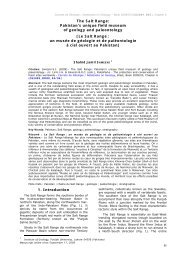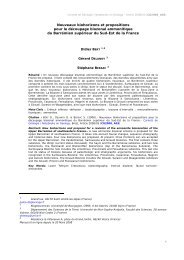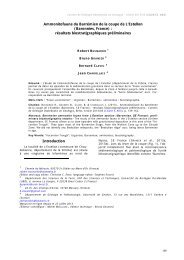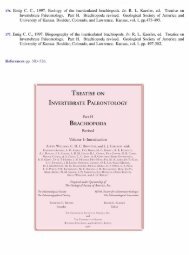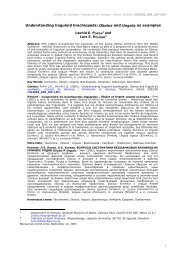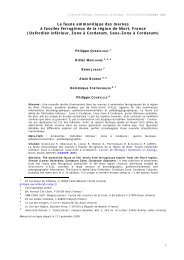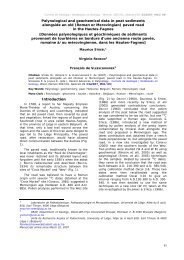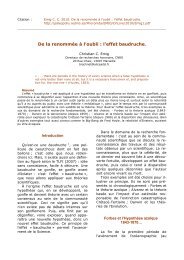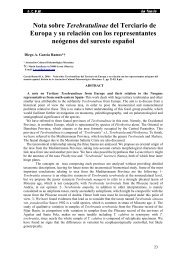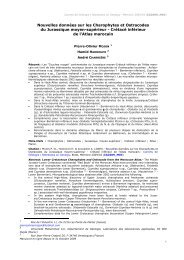PDF version 1749 KB - Paleopolis
PDF version 1749 KB - Paleopolis
PDF version 1749 KB - Paleopolis
Create successful ePaper yourself
Turn your PDF publications into a flip-book with our unique Google optimized e-Paper software.
Carnets de Géologie / Notebooks on Geology - Article 2003/07 (CG2003_A07_SR)Pristiograptus (Graptoloidea) from the perneri - lundgreni biozones(Silurian) of LithuaniaSigitas R ADZEVIČIUS1Abstract: Two new forms of Pristiograptus dubius, here designated as varieties "A" and "B", aredescribed and figured. Both were found in core samples representing the perneri through lundgrenibiozones of the Wenlock epoch. The cores are from boreholes Šiupyliai-69, Parovėja-9, Likėnai-396,Paežeriai-222 and Sutkai-87 in central and northern Lithuania. The associated graptolitesCyrtograptus perneri BOUČEK, C. radians TÖRNQUIST, C. lundgreni TULLBERG, Monograptus flemingiiflemingii (SALTER), M. testis testis (BARRANDE), Monoclimacis flumendosae (GORTANI) andPristiograptus pseudodubius (BOUČEK) (= P. parvus) are all indicative of the perneri, radians andlundgreni biozones of the Wenlock. Two species of Pristiograptus occur in this time-stratigraphicinterval: P. dubius and P. lodenicensis. In P. dubius the degree and manner of extension of thethecal apertural lip (thecal hood) onto the succeeding theca distinguish it from otherwise verysimilar taxa. The thecal morphology of P. lodenicensis differs from that of a typical Pristiograptus inthat the apertural lip has a central depression and is rounded into small lobes laterally.Key Words: Pristiograptus; Graptoloidea; graptolite; Wenlock; Silurian; LithuaniaCitation: RADZEVIČIUS S. (2003).- Pristiograptus (Graptoloidea) from the perneri-lundgreni biozones(Silurian) of Lithuania.- Carnets de Géologie / Notebooks on Geology, Maintenon, Article 2003/07(CG2003_A07_SR)Résumé : Pristiograptus (Graptoloidea) des biozones à perneri, radians et lundgreni (Silurien)de Lithuanie.- Deux formes nouvelles de Pristiograptus dubius, appelées ici variétés "A" et "B", sontdécrites et illustrées. Toutes deux ont été découvertes dans des échantillons de carottes dans unintervalle rapporté aux biozones à perneri, radians et lundgreni du Wenlock. Les carottesproviennent des forages Šiupyliai-69, Parovėja-9, Likėnai-396, Paežeriai-222 et Sutkai-87 deLithuanie centrale et septentrionale. Les graptolites rencontrés en association : Cyrtograptus perneriBOUČEK, C. radians TÖRNQUIST, C. lundgreni TULLBERG, Monograptus flemingii flemingii (SALTER), M.testis testis (BARRANDE), Monoclimacis flumendosae (GORTANI) et Pristiograptus pseudodubius(BOUČEK) (= P. parvus), sont tous caractéristiques des biozones à perneri, radians et lundgreni duWenlock. Deux espèces de Pristiograptus sont connues dans cet intervalle stratigraphique : P.dubius et P. lodenicensis. Chez P. dubius le développement (importance et morphologie) des lèvresaperturales des thèques le long du rhabdosome permet de le distinguer d'autres taxons autrementtrès voisins. La morphologie des thèques chez P. lodenicensis est distincte de celle d'unPristiograptus typique dans la mesure où la lèvre aperturale présente une dépression médiane ets'arrondit latéralement en petits lobes.Mots-Clefs : Pristiograptus ; Graptoloidea ; graptolite ; Wenlock ; Silurien ; LithuanieIntroductionIn the Baltic states the graptolite genusPristiograptus occurs throughout the cyphus toparultimus - ultimus biozones of the Llandoveryto Pridoli. Previously, the genus has beenstudied only cursorily in the interval comprisingthe upper Sheinwoodian-lower Homerianperneri through lundgreni biozones, probablybecause the index taxa for those biozones areCyrtograptus species, quite distinct from thoseused for zonation of the upper Homerian wherePristiograptus species are the markers (Fig. 1).Consequently, this paper is a taxonomic reviewof the representatives of the genusPristiograptus found in these middle Wenlockianlevels where it has been passed over.Pristiograptus of a dubius type dominate inthe perneri - lundgreni biozones. Pristiograptusof a new lodenicensis type appear first in thelundgreni Biozone (see below). It has provedvery difficult in the past to subdivide the dubiusgroup and, thus, indiscriminate identificationslike Pristiograptus ex gr. dubius and/or P.dubius (SUESS) sensu lato abound in theliterature.Previous work on PristiograptusThe Pristiograptus group was investigated indetail by PŘIBYL (1943) who distinguished two'types' based on P. dubius and P. vulgaris (=Colonograptus ludensis) respectively. Hedescribed 23 species of a P. dubius type and 19of a P. vulgaris (= Colonograptus ludensis) typeranging in age from the Late Llandovery to theLudlow of the Czech Republic. URBANEK (1953,1959, 1997) and TELLER (1964) investigated thegenus in Poland. TELLER (1964) described tenspecies and subspecies of the dubius group fromthe Ludlow, eight of which were new.1Department of Geology and Mineralogy, Vilnius University, M. K. Čiurlionio 21/27, Vilnius, LT2000(Lithuania)sigitas.radzevicius@gf.vu.ltManuscript online since November 22, 20031
Carnets de Géologie / Notebooks on Geology - Article 2003/01 (CG2003_A01_JCR-FE)JAWOROWSKI (1965) studied Pristiograptus fromthe lundgreni Biozone. He illustrated five taxaand described a new subspecies: P. lodenicensisperibalticus. JAEGER (1959, 1991) studied thegenus in the upper Wenlock of Germany anddescribed two new species. Some speciesoriginally described as Pristiograptus by theseauthors are now assigned to other recentlyestablished genera such as Colonograptus (e.g.KOREN and URBANEK, 1994; LENZ and KOZŁOWSKA-DAWIDZIUK, 2002) and Pseudomonoclimacis (e.g.URBANEK, 1997). LENZ and MELCHIN (1991)recorded nine Pristiograptus species asoccurring in the Wenlock of Arctic Canada, anddescribed three of them. LENZ (2001) describedonly P. dubius from the lundgreni zone of ArcticCanada; he did not separate the dubius groupinto other species or subspecies. HOLLAND et alii(1969) described the new species P. jaegerifrom the upper Wenlock and lowermost Ludlowof Great Britain and Poland. ZALASIEWICZ andWILLIAMS (1999) recorded the Pristiograptusgroup from the Wenlock of central Wales,recognizing only one subspecies, P. dubiuspseudolatus (RICKARDS).ULST (in GAILITĖ et alii, 1967) worked on thegraptolites of the Baltic area. She described 12species and subspecies of Pristiograptus fromthe Silurian of Latvia, including one new species,P. piltenensis KOREN et ULST (in GAILITĖ et alii,1967), from the upper Wenlock. PAŠKEVIČIUS(1974, 1979) studied Pristiograptus in Lithuaniaand described the new species P. virbalensisfrom the upper Wenlock ludensis Biozone.Figure 1: Correlation of Lithuanian graptolite biozones with those of Arctic Canada (LENZ and MELCHIN, 1991; LENZand KOZŁOWSKA-DAWIDZIUK, 2002); with those of Poland (SZYMANSKI and TELLER, 1998; LENZ and KOZŁOWSKA-DAWIDZIUK,2002) and with those of Central Wales (ZALASIEWICZ and WILLIAMS, 1999).2
Carnets de Géologie / Notebooks on Geology - Article 2003/01 (CG2003_A01_JCR-FE)MaterialThe new Lithuanian material is from theperneri - lundgreni biozones. Much of thematerial consists of specimens (some threedimensional)chemically extracted from therock. The Pristiograptus discussed here are fromboreholes Šiupyliai-69 (interval 1080.5-1004.8m), Parovėja-9 (interval 619.3-545.7 m),Likėnai-396 (interval 638.5-602.9 m), Paežeriai-222 (interval 736.0-690.6 m) and Sutkai-87(interval 821.3-803.7 m) (Fig. 2). In theseboreholes the maximum thickness of strata ofSilurian age is 850 m. In all, about 150 sampleswere collected and investigated. Rhabdosomeswere isolated with HCl from 50 core samples.About 300 isolated fragments of semi-flattenedand 3-dimensionally preserved rhabdosomeswere collected, including unusually earlyastogenetic stages. The associated graptolitesCyrtograptus perneri BOUČEK, C. radiansTÖRNQUIST, C. lundgreni TULLBERG, Monograptusflemingii flemingii (SALTER), M. testis testis(BARRANDE), Monoclimacis flumendosae(GORTANI), Pristiograptus pseudodubius (BOUČEK)(= P. parvus) and P. lodenicensis PŘIBYL areindicative of the perneri, radians and lundgrenibiozones of the Wenlock.Photographs were made using the scanningelectronic microscope (SEM) in the Laboratoryof the Materials Research at Tallinn TechnicalUniversity (Estonia).The material is stored at the Department ofGeology and Mineralogy of Vilnius University(Lithuania).Figure 2: The extent of the Jaagarahu regional Stage (LAPINSKAS, 2000) and location of the boreholes involved. 1)formational boundaries; 2) south of this line Silurian rocks were removed by later erosion; 3) location ofboreholes.BiostratigraphyThe perneri - lundgreni biozones are locatedwithin a locally named regional entity called theJaagarahu Stage (Fig. 1), which includes theupper part of Riga Formation and the Birštonas,Dukstyna and Verknė formations (Fig. 2)(LAPINSKAS, 2000). There are no graptolites inthe Dukstyna and Verknė formations.The perneri Biozone is composed of darkgray argillite with rare clay limestone interbedsin the Šiupyliai-69, Likėnai-369 and Parovėja-9boreholes. In the Sutkai-87 and Paežeriai-222holes, strata representing the perneri Biozoneare gray marls with interbeds of micro-grainedlimestone but it is impossible to define itsboundaries accurately because graptolites arerare. Where graptolites are present in quantitythis association defines the perneri Biozone:3
Carnets de Géologie / Notebooks on Geology - Article 2003/01 (CG2003_A01_JCR-FE)Monograptus flemingii flemingii (SALTER),Monoclimacis flumendosae (GORTANI),Cyrtograptus perneri BOUČEK, C. ellesaeGORTANI. This biozone ranges in thickness from29.5m (Šiupyliai-69) to 33.5m (Parovėja-9).The lithology of the radians Biozone is likethat of the perneri Biozone. The association ofgraptolites: Monograptus flemingii flemingii(SALTER), M. flumendosae (GORTANI),Cyrtograptus radians TÖRNQUIST, C. carruthersiLAPWORTH, is indicative of the radians Biozone.Its thickness ranges between 7.5m (Šiupyliai-69) and 10.7m (Parovėja-9).The lithology of the lundgreni Biozone isidentical to that of the other two. Theassociation of graptolites that defines it is madeup of two groups. One consists of speciespreviously recognized: Monograptus flemingiiflemingii (SALTER), M. flumendosae (GORTANI),Pristiograptus pseudodubius (BOUČEK) (= P.parvus) and the other is made up of morerecently recognized grouping that together withthe older group define the biozone:Eisenackograptus eisenacki (OBUT etSOBOLEVSKAYA), Monograptus flemingiicompactus ELLES et WOOD, M. testis testis(BARRANDE), M. t. inornatus ELLES, Cyrtograptuslundgreni TULLBERG, C. hamatus (BAILY). Itsthickness ranges from 31.5m (Parovėja-9) to50.2m (Šiupyliai-69).TerminologyThis paper employs terminology (Fig. 3)modified from TELLER (1964), URBANEK (1997)and RADZEVIČIUS and PAŠKEVIČIUS (2000):ß - the angle between the thecal apertural lipand the succeeding metathecal wall. Variationsin this angle allows Pristiograptus to be split intogroups (see below).The thecal apertural lip (Fig. 4) is athickening around the aperture. Its form is animportant taxonomic feature in subdividing thegenus (e.g. P. deubeli (JAEGER) (=Colonograptus deubeli), P. lodenicensis, etc.;see Fig. 4).The end of the thecal apertural lip is at thedisto-lateral margin of the thecal aperture. Itslocation is a very important taxonomic featurein distinguishing forms of the dubius group.The author is of the opinion that the thecalapertural lip (thecal hood) may be linked to thedevelopment of the ectocortex. It is not theresult of deformation because some of materialis three-dimensional. The internal structure ofPristiograptus was not studied, but will beinvestigated in the future. These morphologicalelements should be excellent features fordiscriminating between the several formsassigned to Pristiograptus ex gr. dubius, makingtheir recognition easier.Figure 3: Morphological elements of a Pristiograptusrhabdosome: th 1 - the first theca, ß - angle betweenthecal aperture and succeeding theca; - anglebetween thecal axis and virgula.The following abbreviations are used in thedescriptions below: L - length of rhabdosomeincluding sicula; W - rhabdosome dorso-ventralwidth; th 1 , th 2 , etc. - theca 1, theca 2, etc.4
Carnets de Géologie / Notebooks on Geology - Article 2003/01 (CG2003_A01_JCR-FE)Figure 4: The forms of thecal apertural lip: A-C Pristiograptus of a dubius type; A - P. pseudodubius (= P.parvus): the thecal apertural lip terminates in the middle part of the succeeding theca (tal); B - P. dubius var."A": the thecal apertural lip joins the apertural lip of the succeeding theca (tal); C - Pristiograptus sp., theapertural lip of a theca joins the apertural lip of the succeeding theca (tal) and bifurcates to produce anintergrowth arch (ia); D - Monoclimacis sp., the apertural lip of the theca forms an apertural hood (tal); E - P.lodenicensis, the thecal apertural lip has a small central depression (dep); F - Pseudomonoclimacis labiatus(URBANEK, 1997) the thecal apertural lip has a large central depression.Figure 5: A-I Pristiograptus dubius var. "A", Parovėja-9 borehole, depth 605.25-602.9m; A - S.P9-220, type,showing the thecal apertural lip connecting with that of the succeeding theca (tal); B - S.P9-223, with long virgula(v); C - S.P9-215a, prosicula (psi) and double, juvenile, virgula (v2); D - S.P9-215b, sicula showing the openprimary notch (pn); E - S.P9-215c, sicula; F - S.P9-215d, sicula with possible open primary notch (pn?); G - S.P9-214, small protrusion in the middle part of virgella (vin); H - S.P9-215e, sicula with th 1; I - S.P9-215f, sicula withth 1.5
Carnets de Géologie / Notebooks on Geology - Article 2003/01 (CG2003_A01_JCR-FE)Systematic descriptionsUsing these newly recognized morphologicalelements, the author describes two forms ofPristiograptus ex gr. dubius. They may well befound to be subspecies as material from otherareas becomes available to demonstrate theirgeographic extent and persistence.Family Monograptidae L APWORTH , 1873Genus Pristiograptus J AEKEL , 1889Type species. Pristiograptus frequensJAEKEL, 1889Pristiograptus dubius group, P ŘIBYL ,1943Type species. Pristiograptus dubius dubius(SUESS), SUESS, p. 115, pl. 9, figs. 5.a-b,riccartonensis Biozone, lower Wenlock, Silurianof Vyskočilka, Male Chuchle (Czech Republic).Diagnosis. The rhabdosome is robust. Theproximal end generally has a slight ventralcurvature up to th 4 -th 6 ; sometimes it is straight.Thecae are uniform, cylindrical, and inclined tothe rhabdosomal axis at 25-35º. There is adistinct thickening of the thecal aperturalmargin, the thecal apertural lip, which extendsonto the lateroventral wall of the succeedingtheca. The angle (ß) between the aperturalmargin of the theca and the succeeding thecalwall is always obtuse, especially in the moreproximal thecae. The sicula is conical with ashort and thin, slightly curved virgella.Age and geographic distribution.Pristiograptus of the dubius type is widespreadhaving been recorded from: Lithuania, Latvia,Poland, Russia, the Czech Republic, Sweden,Germany, Bulgaria, Arctic Canada, Australia,British Isles, France, Italy, Tunisia, Algeria, andMorocco, etc. The group ranges from the UpperLlandovery to the Prídolí.Pristiograptus dubius var. "A"Derivation of name. Temporarydesignation pending additional confirmation ofthe ubiquity and persistence of thecharacteristics defining the variety.Material. About 25 rhabdosomes andadditional fragments from the Parovėja-9borehole, depth 605.25-590.5 m.Description. The rhabdosome is robust andstraight, although some specimens show ventralcurvature proximally. L is >11.5mm. Thecollection includes only one complete specimen(Fig. 5 B). The rhabdosome widens graduallyfrom 0.8mm at th 1 , to 0.9mm at th 2 , 1mm atth 3 , and 1.2mm at th 4 . W max is 1.7mm. Theminimum W (= inter-apertural width) is0.55mm at th 1 , 0.65mm at th 2 , 0.85mm at th 3 ,0.95mm at th 4 , and 1.05mm at th 5 . There are5-5.5 thecae in 5mm. Thecae are cylindrical.Th 1 is 1mm long. The free part of each theca ishalf of its whole length. The thecal apertural lipis distinct (Fig. 5 A-B & G) and connects withthat of the succeeding theca (Fig. 6 A) exceptapparently in th 1 and th 2 (Fig. 6 B) although itmay have been obscured in these thecae byovergrowth of cortical tissue. The apertural lipconnection is particularly obvious in the medialand distal portions of the rhabdosome (Fig. 7).The thecae are inclined at 30º to the virgula.The sicula is short and narrow. Its L is 1.8mmand apertural W is 0.4mm. The apex of thesicula reaches the base of th 3 . Th 1 rises 0.1mmabove the aperture. The aperture is concave inprofile view. The virgella is short, up to 0.6mmlong. In one specimen there is a thickenedprotrusion (Fig. 5 A & G, 6 D).Comparison. Pristiograptus dubius var. "A"differs from P. pseudodubius (= P. parvus), P.dubius dubius and P. dubius var. "B" in theconnection of the thecal apertural lip to thesucceeding theca. In P. dubius dubius and P.dubius var. "B" the thecal apertural lip does notreach the middle of the free ventral wall of thesucceeding theca and in P. pseudodubius itreaches only the middle of the free ventral wallof the succeeding theca. Also, P. dubius var. "B"differs from P. dubius var. "A" in its longervirgella - 1.35 mm, as compared with 0.6 mm.The width of P. dubius var. "B" does not exceed1.1 mm at th 4-5 .Association. P. dubius var. "A" is found withCyrtograptus perneri (BOUČEK), Monograptusflemingii flemingii (SALTER), Monoclimacisflumendosae (GORTANI), P. pseudodubius(BOUČEK) (= P. parvus) and P. sp.Fig. 5 A-I, 6 A-E, 7 A-CType. No S.P9-220, Fig. 5 A, Parovėja-9borehole, depth 605.25 m, Cyrtograptus perneriBiozone.6
Carnets de Géologie / Notebooks on Geology - Article 2003/01 (CG2003_A01_JCR-FE)Figure 6: A-C Pristiograptus dubius var. "A", Parovėja-9 borehole, depth 605.25m; A-B & D-E - S.P9-214, A -proximal end: view of rhabdosome, virgella (vir), th 1 (th 1), thecal apertural lip of th 4 (th 4tal), th 5 (th 5); B - th 1 andth 2, note unclear apertural lip of the first theca on the second theca (th 1tal); D - the virgella with a smallprotrusion in the middle (vin) and the lip of the sicular aperture (sal); E - thecal apertural lip of th 4 joining that ofth 5 (tal); C - S.P9-215e, sicula with virgula (v), prosicula (psi), virgella (vir) and th 1 (th 1).Age and geographical distribution. P.dubius var. "A" is widespread throughoutnorthern Lithuania in the upper part of the RigaFormation, in the perneri Biozone of theSheinwoodian Stage itself comprising the lowerportion of a locally denominated entity, theJaagarahu regional Stage.Pristiograptus dubius var. "B"Fig. 8 A-G, 9 A-DType. No. S.P222-229, fig. 8 A, Paežeriai-222 borehole, depth 730m, Cyrtograptuslundgreni Biozone.Derivation of name. Temporarydesignation pending additional confirmation ofthe ubiquity and persistence of thecharacteristics defining the variety.Material. About 20 rhabdosomes andadditional fragments from Paežeriai-222borehole, depth 734.5-730m, Likėnai-396borehole, depth 577.0-605.9m, Šiupyliai-69borehole, depth 1007.0m.Description. The rhabdosome is straightand narrow. L is >12.5mm. The collectionincludes only one complete specimen (Fig. 9 A).W is 0.7mm at th 1 , 0.75mm at th 2 , 0.85mm atth 3 , 0.95mm at th 4 , and 1mm at th 5 . W max is1.1mm. The minimum, inter-apertural width is0.5mm at th 1 , 0.6mm at th 2 , 0.75mm at th 3 ,0.8mm at th 4 , and 0.9mm at th 5 . There are 5-5.5 thecae in 5mm. The free part of each thecais half of its entire length. The thecal aperturallip is distinct (Fig. 8 A-B), extending onto theventral wall of the succeeding theca, but notreaching its apertural lip (Fig. 9 A), but endingmidway up the ventral wall (Fig. 9 C). Thecaeare inclined at 30º to the virgula. The sicula is2mm long and its apertural width is 0.35mm.The apex of sicula is at approximately the levelof the apertural lip of th 2 . Th 1 arises 0.2mm7
Carnets de Géologie / Notebooks on Geology - Article 2003/01 (CG2003_A01_JCR-FE)above the sicular aperture. The virgella is long(1.35 mm) and narrow (Fig. 9 D).Comparison. See under Pristiograptusdubius var. "A".Association. Pristiograptus dubius var. "B"is found with Monograptus flemingii flemingii(SALTER), M. f. compactus ELLES et WOOD, M.testis testis (BARRANDE), M. t. inornatus ELLES,Pristiograptus pseudodubius (BOUČEK) (= P.parvus), Monoclimacis flumendosae (GORTANI),Cyrtograptus lundgreni TULLBERG,Paraplectograptus tenuis (EISENACK) andEisenackograptus eisenacki (OBUT etSOBOLEVSKAYA).Age and geographic distribution.Pristiograptus dubius var. "B" is widespreadthroughout central and western Lithuania. It isfound in the lundgreni Biozone of the LowerHomerian Stage within the Jaagarahu regionalStage which spans the upper part of the RigaFormation and the overlying BirštonasFormation.Figure 7: A-C Pristiograptus dubius var. "A",Parovėja-9 borehole, depth 605.25m, S.P9-214a; A -general view of medial part of rhabdosome; B-C -connection of thecal apertural lip to the apertural lipof the succeeding theca (tal).Pristiograptus sp.Fig. 10 A-EMaterial. One specimen, no S.P9-219, fromthe Parovėja-9 borehole, depth 595.4m;rhabdosome with th 1-8 .Description. The rhabdosome is straight,massive. L is >11.1mm. The rhabdosomewidens gradually. W is 0.8mm at th 1 , 1mm atth 2 , 1.1mm at th 3 , 1.3mm at th 4 , and 1.4mm atth 5 . W max is 1.6mm. The interapertural width is0.57mm at th 1 , 0.68mm at th 2 , 0.73mm at th 3 ,0.91mm at th 4 , and 0.91mm at th 5 . There are5-5.5 cylindrical thecae in 5mm. Th 1 is 1.6mmlong. The free portion of each theca is equal tohalf of its length. The thecal apertural lip isdistinct (Fig. 10 B), extending over the free partof the succeeding theca and connecting with itsapertural lip (Fig. 10 A). This connection iseasily discernible in the medial and distal partsof the rhabdosome. Th 1 and th 2 either do nothave such thecal apertural lip connections orthey are covered by cortical tissue (Fig. 10 D).The thecal apertural lip bifurcates (Fig. 10 D) afeature well developed in the distal part of therhabdosome. An intergrowth arch is welldeveloped especially in the proximal part of therhabdosome (Fig. 10 C). The distance betweenthe thecal apertural lip connection on thesucceeding theca and the origin of its bifurcationis 0.25mm for th 1 and th 2 , and 0.35mm for th 3-5. Thecae are inclined at 30º to the virgula. Thesicula is short and narrow, 2mm long with anapertural width of 0.4mm. The apex of thesicula reaches the base of the th 2 /th 3 interthecalseptum. Th 1 arises 0.15mm above the sicularaperture. The sicular aperture is stronglyconcave in profile view (Fig. 10 E). The virgellais thick and short (Fig. 10 E), 0.74mm long.Comparison. Pristiograptus sp. differs fromP. pseudodubius (= P. parvus), P. dubiusdubius, and Pristiograptus dubius var. "A" in thelength and form of the thecal apertural lip in itsconnection with the succeeding thecal aperturallip. The thecal apertural lip of Pristiograptus sp.extends over the free part of the succeedingtheca and connects with its apertural lip. In P.dubius dubius and P. dubius var. "B" theextension of the thecal apertural lip does notattain the middle of the free part of thesucceeding theca. In P. pseudodubius theextension reaches the middle of the free portionof the succeeding theca. P. sp. differs from P.dubius var. "A" in that the thecal apertural lipbifurcates in the middle of the free part of thesucceeding theca. P. dubius var. "A" lacks such abifurcation.8
Carnets de Géologie / Notebooks on Geology - Article 2003/01 (CG2003_A01_JCR-FE)Figure 8: A-G Pristiograptus dubius var. "B". A - S.P222-229, type, virgella (vir), the end of the thecal aperturallip (tal), Paežeriai-222 borehole, depth 730m; B - S.L396-218a, proximal part of rhabdosome with the end of thethecal apertural lip (tal), Likėnai-396 borehole, depth 605.9m; C - S.S69-228a, sicula with th 1 and th 2, Šiupyliai-69borehole, depth 1007m; D - S.P222-217a, sicula with long virgella (vir) and th 1, Paežeriai-222 borehole, depth734.5m; E - S.L396-231a, sicula, Likėnai-396 borehole, depth 577m; F - S.P222-230a, sicula with possible openprimary notch (pn?), Paežeriai-222 borehole, depth 730m; G - S.L396-231b, sicula with incomplete th 1, Likėnai-396 borehole, depth 577m.Association. Pristiograptus sp. is found withCyrtograptus perneri (BOUČEK), Monograptusflemingii flemingii (SALTER), Monoclimacisflumendosae (GORTANI), Pristiograptuspseudodubius (BOUČEK) (= P. parvus), and P.dubius var. "A".Age and geographic distribution.Pristiograptus sp. is recorded only from theParovėja-9 borehole, northern Lithuania, in theperneri Biozone of the Sheinwoodian Stage.Pristiograptus lodenicensis was investigatedby RADZEVIČIUS and PAŠKEVIČIUS (2000). The datain the accompanying table are unchanged fromthat presentation. But new pictures and photosimprove the appreciation of their significance.9
Carnets de Géologie / Notebooks on Geology - Article 2003/01 (CG2003_A01_JCR-FE)virgella.Remarks. All species not belonging to thedubius group, including P. lodenicensis, werepreviously assigned to the vulgaris group(PŘIBYL, 1943). Subsequently, P. vulgaris(WOOD) was synonymised with P. ludensis(MURCHISON), so this group must be renamed.The taxonomic position of the lodenicensis groupis not clear because P. lodenicensis is not atypical Pristiograptus. The thecae are similar tothose of Colonograptus (e.g. Colonograptusgerhardi (KÜHNE)), differing only in the lessercurvature of the lip of the thecal aperture, as isalso the case with Pseudomonoclimacis (e.g.Pseudomonoclimacis latilobus (TSEGELNIUK)) andMonograptus massai JAEGER, the latter recordedfrom the Ludlow of NW Libya. This Libyanspecies can be assigned the lodenicensis groupas it possesses a typical Pristiograptus sicula.Age and geographic distribution. Thelodenicensis group is known from the lundgreniBiozone of Lithuania, Latvia, the Czech Republicand Poland.Pristiograptus lodenicensis P ŘIBYL(1943)Fig. 11 A-H, 12 A-FFigure 9: A-D Pristiograptus dubius var. "B", P.P222-216, Paežeriai-222 borehole, depth 734.5m. A -general view of proximal portion of a rhabdosomewith virgula (v) and th 1 (th 1); B - apertural lip of th 5(th 5tal); C - end of the thecal apertural lip of th 2(tal); D - sicular aperture with dorsal lip (sal) andlong virgella (vir).Pristiograptus lodenicensis group,R ADZEVIČIUS et P AŠKEVIČIUS , 2000Type species. Pristiograptus lodenicensisPŘIBYL, PŘIBYL, 1943, p. 21, pl. 1, figs. 4 & 6,Cyrtograptus lundgreni Biozone, Wenlock,Silurian of Lodenice-Budovice (Czech Republic).Diagnosis. The rhabdosome is massive. Theproximal end is straight or ventrally curved upto th 4 or th 5 . Thecae are uniform and widentowards their apertures, which show smalldepressions centrally. Thecal apertures areperpendicular to the rhabdosomal axis. Thesicula is small and conical with a slender, short• 1943 Pristiograptus lodenicensis PŘIBYL;p. 23-24, text-figs. C-D & J-K; pl. III, figs. 8-11;• 1952 Pristiograptus lodenicensis PŘIBYL;MÜNCH: p. 91, pl. 20, fig. 7;• 1967 Pristiograptus lodenicensis PŘIBYL;KOREN and ULST in GAILITĖ et alii: p. 244, textfig.58; pl. XXIX, figs. 4-5;• 1974 Pristiograptus lodenicensis PŘIBYL;ULST: p. 115, pl. XIII, figs. 1-2.a-b; pl. XI, fig7;• 2000 Pristiograptus lodenicensis PŘIBYL;RADZEVIČIUS and PAŠKEVIČIUS: p. 97-98, pl. IV,figs. 1.a-c, 2.a-c; pl. VI, fig. D.Holotype. Pristiograptus lodenicensis PŘIBYL,1943. Plate I, fig. 2. Upper Wenlock (Homerianstage), Cyrtograptus lundgreni Biozone.Material. About 50 rhabdosomes andfragments from the Kurtuvenai-161, Likėnai-396and Parovėja-9 boreholes. Some specimensfrom Parovėja-9 were chemically prepared.10
Carnets de Géologie / Notebooks on Geology - Article 2003/01 (CG2003_A01_JCR-FE)Figure 11: Pristiograptus lodenicensis PŘIBYL, all specimens from the Parovėja-9 borehole, A - P.P9-5, rhabdosomewith virgula (v) and sicula (si); there is a small depression of the thecal apertural lip of th 3 (ex), depth 558.3m; B- P.P9-208a, sicula, depth 5583m; C - P.P9-202a, sicula with beginning of th 1 (th 1), depth 547.7m; D - P.P9-202b,sicula with incomplete th 1 (th 1) and virgula (v), depth 547.7m; E - P.P9-6, proximal part of rhabdosome, depth561.9m; F - P.P9-1, th 1-th 5, with a small depression on the apertural lip of th 2 (ex) and a virgella (vir), depth561.9 m; G - P.P9-208b; sicula with open primary notch (pn), depth 558.3m; H - P.P9-208c sicula, virgella (vir)and th 1 (th 1), depth 558.3m.Association. P. lodenicensis is found withMonograptus flemingii flemingii (SALTER), M. f.compactus ELLES et WOOD, M. testis testis(BARRANDE), M. t. inornatus ELLES, Pristiograptuspseudodubius (BOUČEK) (= P. parvus),Monoclimacis flumendosae (GORTANI),Cyrtograptus lundgreni TULLBERG,Paraplectograptus tenuis (EISENACK) andEisenackograptus eisenacki (OBUT etSOBOLEVSKAYA).Age and geographic distribution. P.lodenicensis is widespread in the East Balticarea: (Lithuania, Latvia). It is found in theupper part of Riga Formation and in theBirštonas Formation, in the lundgreni Biozone ofthe Homerian Stage, Jaagarahu regional Stage.P. lodenicensis is also found in the CzechRepublic, and Poland.AcknowledgementsI am grateful to Juozas PAŠKEVIČIUS forproviding the material and to Petras MUSTEIKISfor reading the manuscript and for criticalremarks. I thank Jan ZALASIEWICZ, DavidLOYDELL, Alfred LENZ, Philippe LEGRAND and an"anonymous reviewer" for helpful suggestions,corrections and improvements. I am obliged to12
Carnets de Géologie / Notebooks on Geology - Article 2003/01 (CG2003_A01_JCR-FE)Jurga STASEVIČIUTE, David LOYDELL and NestorSANDER for improvements in the English of thepresentation.ReferencesGAILITĖ L., RYBNIKOVA M., ULST R. (1967).-Stratigraphy, fauna and formation conditionsof Silurian rock in the Middle Baltic State [InRussian].- Izdatel'stvo Zinatne, Riga, 304 p.HOLLAND C.H., RICKARDS R.B., WARREN P.T.(1969).- The Wenlock graptolites of theLudlow district, Shropshire and theirstratigraphical significance.- Palaeontology,London, Vol. 12, Part 4, pp. 663-683.JAEGER H. (1959).- Graptolithen undStratigraphie des jüngsten Thüringer Silurs.-Abhandlungen der Deutschen Akademie derWissenschaften zu Berlin, Berlin, Klasse fürChemie, Geologie und Biologie, Jahrgang1959, Nr. 2, 197 p.JAEGER H. (1991).- Neue Standard-Graptolithenzonenfolge nach der "GrossenKrise" an der Wenlock/Ludlow Grenze(Silur).- Neue Jahrbuch für Geologie undPaläeontologie, Abhandlungen, Stuttgart,182 (3), pp. 303-354.JAWOROWSKI K. (1965).- Strop warstw posłeckichw obniženiu litewskim a granica wenlockludlow.-Kwartalnik Geologiczny, Warsaw, 9(3), pp. 511-527.KOREN T.N., URBANEK A. (1994).- Adaptativeradiation of monograptids after the LateWenlock crisis.- Acta PalaeontologicaPolonica, Warsaw, Vol. 39, No. 2, pp. 137-167.LAPINSKAS P. (2000).- Structure andpetroliferosity of the Silurian in Lithuania.-Institute of Geology, Vilnius, 203 p.LENZ A.C., KOZŁOWSKA-DAWIDZIUK A. (2001).-Late Wenlock (Silurian) graptolites of ArcticCanada: pre-extinction, lundgreni Biozonefauna.- Palaeontolographica Canadiana, St.John's, Nº 20, 61 p.LENZ A.C., KOZŁOWSKA-DAWIDZIUK A. (2002).-Upper Homerian (Upper Wenlock, Silurian)graptolites from Arctic Canada.- Journal ofPaleontology, Tulsa, 76, pp. 321-346.LENZ A.C., MELCHIN M.J. (1990).- Wenlock(Silurian) graptolites, Cape PhilipsFormation, Canadian Arctic Island.- CanadianJournal of Earth Sciences, Ottawa, 27, pp. 1-13.Figure 12: A-F Pristiograptus lodenicensis PŘIBYL, A-B & E - S.P9-211a, depth 558.3m, medial part of rhabdosomewith thecal apertural lip (tal); B & E - depression of thecal apertural lip (ex); C-D & F - P.P9-1, depth 561.9m; C -th 1-th 5 with sicula (si) and virgula (v); D - thecal apertural lip of th 3 (tal) and its depression (ex); F - th 1-th 2, withsicula (si) and virgella (vir).13





